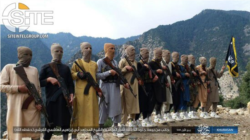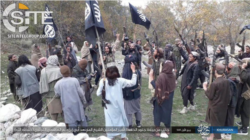The latest wave of endorsements for new Islamic State leader Abu Ibrahim al-Hashimi al-Qurashi has U.S. intelligence officials taking notice.
IS media operatives Tuesday disseminated more photographs of fighters from the group's various affiliates giving bay'ah, or loyalty, to Qurashi, including a series of 16 photographs from IS-Khorasan, as Afghan affiliate is known.
The photos appear to show several groups of fighters, from different locations, carrying IS banners and raising their fists or their guns as they pledge their allegiance to the newly named caliph.
"Of all of the branches and networks of ISIS, ISIS-K is certainly one of those of most concern," Russell Travers, acting director of the U.S. National Counterterrorism center, told a panel of lawmakers late Tuesday.
U.S. and Western intelligence officials have long pointed to IS-Khorasan as one of the most resilient of the terror organization's affiliates, surviving repeated attempts by U.S. and Afghan forces to annihilate its leadership and fighters.
It is also one of the most ambitious.
"They have attempted, certainly, to inspire attacks outside of Afghanistan," Travers said, adding, "they certainly have got the desire" to carry out the attacks themselves.
But beyond simply having deadly ambitions, officials fear IS-Khorasan has the manpower and could soon have the capabilities to put their plans into action.
Having seen it numbers fall into the low hundreds after the U.S. dropped the largest non-nuclear bomb in its arsenal -- a GBU-43 Massive Ordnance Air Blast -- on a cave and tunnel system in Afghanistan's Nangarhar province, IS-Khorasan has rebounded.
Travers said Tuesday IS-Khorasan likely has about 4,000 fighters, though U.S. military officials warn the figure could be closer to 5,000, making it one of the largest IS affiliates.
Its size, combined with its reputation, could give Qurashi a boost as the newly named IS leader tries to cement his standing with the terror group's other branches.
"Their message seems to be that it's business as usual and that nothing has changed except for their leader," said Raphael Gluck, co-founder of Jihadoscope, another company that monitors online activity by Islamist extremists.
"They want to show they can mobilize and fast, and that the caliphate is still there," he said.
The release of the photos from IS-Khorasan is the latest in the terror group's campaign to create the appearance of momentum, having already shown five other affiliates back Qurashi as he takes the helm.
Early pledges
The first of the pledges came Saturday -- media officials distributing three photographs from IS-Sinai showing about 25 masked fighters gathering in a sparsely wooded area in Egypt's Sinai Peninsula, with guns raised.
Hours later, IS media officials released a series of photographs showing a group of about seven or eight masked fighters, allegedly from Bangladesh, pledging their loyalty.
Similar photographs have also surfaced from Pakistan, Yemen, and Somalia, as well as from Syria's Daraa province.
"Some of this is, we're seeing some of the weaker affiliates rapidly realign with Islamic State," said Katherine Zimmerman, project manager with the American Enterprise Institute's Critical Threats Project of the initial pledges of loyalty.
"Four of the five are actually pretty small affiliates — Yemen, Somalia, Bangladesh and Pakistan — that haven't really had a massive presence on the ground and don't seem to have the sort of global pull that other ISIS branches have had," she added.
The exception is IS-Sinai, seen by Western intelligence officials as one of the terror group's most dangerous affiliates, capable of fielding anywhere from 500 to 1,200 fighters.
But while there has been a sense in the intelligence community that most of the IS affiliates eventually will fall in line behind Qurashi, some affiliates may be trying to feel out the terror group's core leadership to see if financial and logistical support will continue.
They also may want more information about Qurashi's true identity, to evaluate whether he can bring the same cachet as Abu Bakr al-Baghdadi, who helped guide IS from a struggling insurgency into one of the world's most feared terror organizations.
'Risk of defections'
Officials and analysts say it may be telling if or when fighters with some of IS' African affiliates, including IS-West Africa, with an estimated 3,500 fighters, come forward to pledge their loyalty to Qurashi.
"There is also the perception that ISIS was simply gaining ground in the world of jihadism," Daveed Gartenstein-Ross, a counterterrorism analyst and CEO of Valens Global, told VOA prior to Thursday's announcement that Qurashi is now in charge.
"If the new leader is not seen as a sufficient replacement for Baghdadi, then they do face the risk of defections," he said.
But early indications are that the strategy of gradually building momentum appears to be working.
"ISIS supporters on social media platforms seem to have a renewed sense of belonging since the announcement of the new caliph," according to Chelsea Daymon, a terrorism and security researcher at American University.
"Supporters are definitely keeping track of what's being written and said," she added.









